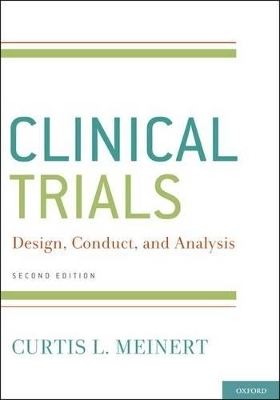
ClinicalTrials
Oxford University Press Inc (Verlag)
978-0-19-538788-9 (ISBN)
First published in 1986, this landmark text is the definitive guide to clinical trials, written by one of the leading experts in the field. This fully-updated second edition continues to be the most authoritative reference text on randomized clinical trials. It contains a wealth of practical information on the design, conduct, and analysis of both single center and multicenter trials. No other book on clinical trials offers as much detail on such issues as sample size calculation, stratification and randomization, data systems design, development of consent forms, publication policies, preparation of funding requests, and reporting procedures.
While the basics of design, conduct, and analysis of clinical trials remain the same, there have been significant changes since the first edition of Clinical Trials was published two decades ago. In this new edition, the author discusses the refinements and improvements made to methods and procedures, changes in the policies and guidelines underlying trials, as well as requirements for registration of trials. He also discusses current practices for data sharing, for gender representation, for treatment effects monitoring, and for ethical standards of clinical trials. The importance of the randomized controlled trial has grown significantly over time and they are now the cornerstone of all evidence-based medicine. Still rich in tables, checklists, charts, and other resources for the trialist, the second edition of Clinical Trials is an indispensable reference for clinicians, biostaticians, epidemiologists, and anyone involved in the design and implementation of a clinical trial.
Curtis L. Meinert, PhD, is a Professor in the Departments of Epidemiology and Biostatistics at the Johns Hopkins Bloomberg School of Public Health. He was founder of the Center for Clinical Trials and served as its director through September 2005. He was a founding member of the Society for Clinical Trials and was Editor of Controlled Clinical Trials from its inception in 1980 through 1993.
Part 1: Introduction ; 1. Introduction ; 2. The language of clinical trials ; 3. Types and classes of trials ; 4. The state and nature of trials ; 5. The activities of clinical trials ; 6. Coordinating and other resource centers in multicenter trials ; 7. Multi-study networks ; 8. Ethical principles and imperatives in clinical trials ; 9. Objectivity versus competency in clinical trials ; Part 2: Design principles and practices ; 10. Fundamentals of controlled clinical trials ; 11. Bias ; 12. Bias control ; 13. Variance control ; 14. The study treatments ; 15. Outcome measures ; 16. Sample size and power estimates ; 17. Randomization ; 18. Treatment masking ; 19. The study plan ; 20. Data collection considerations ; Part 3: Execution ; 21. Data collection forms ; 22. Start-up and maintenance procedures ; 23. Participant recruitment and enrollment ; 24. Patient followup, close out, and post trial followup ; 25. Midcourse changes and coping strategies ; 26. Adverse events (AEs) ; 27. Quality assurance ; Part 4: Data analysis ; 28. Basic data analysis and counting principles for primary results publications ; 29. Study datasets ; 30. Basic data analysis procedures ; 31. Questions concerning the design, analysis, and interpretation of clinical trials ; 32. Treatment effects monitoring ; 33. Issues in treatment effects monitoring ; 34. Subgroup analyses ; Part 5: Organization and management ; 35. Funding ; 36. Organizational design and structure ; 37. Study governance ; 38. Study organizational structures and meetings ; 39. Regulations, requirements, policies, and guidelines ; Part 6: Publication ; 40. The publication imperative ; 41. Presentation, publication, information, and data access policies ; 42. Preparation of study publications ; 43. Document and report production ; 44. Reading reports of trials ; Part 7: Miscellaneous ; 45. Scientific integrity ; 46. Transgressions of trialists ; 47. Homogeneity versus heterogeneity in trials ; 48. Meta-analysis ; 49. The University Group Diabetes Program (UGDP) ; 50. Training trialists ; 51. Comparative effectiveness research (CER) and clinical trials ; 52. Readings and reference materials ; Part 8: Appendices ; A. Glossary of definitions ; B. Terminology usage and recommendations ; C. Medical research codes of ethics ; D. Teaching questions and answers ; E. Aids for trialists ; F. Data items and forms illustrations ; G. Randomization illustrations ; H. Activities by stage of trial ; I . Sketches of trials: Year 2006 publications in NEJM, JAMA, Br Med J, and Lancet ; J. Sample study documents ; K. User datasets ; L. Abbreviations ; References ; Index
| Erscheint lt. Verlag | 19.4.2012 |
|---|---|
| Reihe/Serie | Monographs in Epidemiology and Biostatistics |
| Zusatzinfo | 20 line art |
| Verlagsort | New York |
| Sprache | englisch |
| Maße | 254 x 180 mm |
| Gewicht | 1406 g |
| Themenwelt | Studium ► Querschnittsbereiche ► Epidemiologie / Med. Biometrie |
| Studium ► Querschnittsbereiche ► Prävention / Gesundheitsförderung | |
| ISBN-10 | 0-19-538788-0 / 0195387880 |
| ISBN-13 | 978-0-19-538788-9 / 9780195387889 |
| Zustand | Neuware |
| Haben Sie eine Frage zum Produkt? |
aus dem Bereich


